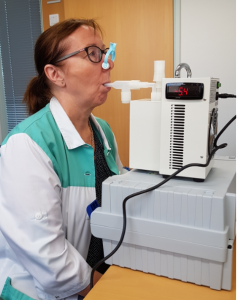HBM4EU work on occupational exposure to chemicals
Occupational exposures to specific chemicals may, in many instances, be several times higher than environmental exposures experienced by the general population. Human biomonitoring provides a valuable tool for understanding human exposure to chemicals in the workplace and ensuring safety at work.
In terms of undertaking human biomonitoring studies, a typical challenge in occupational studies is the low number of workers that can be recruited in national studies. As is in the case for human biomonitoring studies assessing environmental exposure, the studies performed by different researchers in individual countries are usually not aligned with respect to sampling, analytical methodologies or data collection. This complicates the comparison of the findings and the use of the data in regulatory risk assessment at European level.
Combining results from national surveys that have used harmonized study designs and methodologies can greatly improve the usefulness of the information collected from occupational studies and deliver added value at EU level.
Within HBM4EU, we are implementing three targeted occupational studies focusing on different priority substances. The first one is an occupational study on hexavalent chromium [Cr(VI)] exposure, which began in 2018. The analysis of the results is currently ongoing and will be finished by June 2020.
Under HBM4EU, the second occupational study with two focuses, exposure to diisocyanates and exposures in E-waste handling, has been planned and will be conducted in 2020-2021.
HBM4EU chromate study brings new information on the occupational exposure to hexavalent chromium
Hexavalent chromium (Cr(VI)) is a carcinogen to which people are exposed in the workplace. Although Cr(VI) compounds are subject to authorisation under Regulation (EC 1907/2006) concerning the Registration, Evaluation, Authorisation and Restriction of Chemicals (REACH), these compounds are still widely used in different applications, especially in surface treatment of different metallic objects. In addition, workers may be exposed to Cr(VI) formed during hot processes, like welding. Although these exposures are not covered by REACH, there is a binding occupational limit value (BOELV) set under EU Directive 2004/37/EC for Cr(VI) to control occupational exposures to Cr(VI) in all processes. It is, however, unclear how well workplaces perform relative to this exposure level.
According to preliminary results, chrome platers show the highest urinary chromium levels, which are in some cases more than 10-times higher than the levels measured in the control population. While in the control population urinary chromium levels usually remain below 1 µg/g creatinine, in surface treatment workers the levels vary from these background levels up to 10 µg/g creatinine. Interestingly, in some cases, chromium levels in samples taken from workers prior to starting their shifts were higher than in the general population. Although workers performing welding also show elevated levels, these seem to be lower than the levels seen in workers performing chrome plating.
In addition to urinary chromium, we have evaluated the capability of new, more specific HBM parameters for the assessment of Cr(VI) exposure. These include chromium levels in red blood cells and Cr(VI) levels in exhaled breath condensate. According to preliminary results, exhaled breath condensate samples show the same trend as seen in urinary chromium, whereby chrome platers show higher exposure than welders. Welders do also show elevated levels compared to the controls.
Analysis of air samples and wipe samples collected from the hands of workers will give us information on the exposure routes. This can be then used to give recommendations for how to implement risk management measures to minimise exposure to Cr(VI) at workplaces.
The HBM4EU study on Cr(VI) provides a good model that can be applied to other European occupational studies involving multiple countries.

The picture shows a laboratory technician providing a breath sample.
The analysis of exhaled air has several advantages since it is a noninvasive method applicable to a large number of toxic agents.
Exhaled breath samples are tested as a novel matrix for the biomonitoring of hexavalent chromium.
© TTL
Disclaimer
The HBM4EU project was launched in 2016 with the aim of improving the collective understanding of human exposure to hazardous chemicals and developing HBM as an exposure assessment method. The project had €74m in funding and jointly implemented by 120 partners from 28 participating countries – 24 EU member states plus Norway, Switzerland, Iceland and Israel and the European Environment Agency. One of its aims was to ensure the sustainability of HBM in the EU beyond 2021. The project ended in June 2022. The website will not be updated any longer, except the page on peer reviewed publications, but will be online until 2032.


